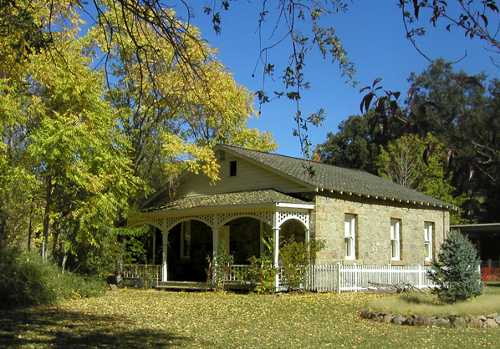CLEARLAKE, Calif. – On Friday a Lower Lake man charged with fleeing the scene of a crash that mortally injured a Kelseyville restaurateur in September was sentenced to four years in prison.
James Walter Nightingale, 31, went before Judge Stephen Hedstrom in the Lake County Superior Court's Clearlake Division for the sentencing hearing, which ran nearly three hours on Friday afternoon.
Nightingale was charged with felony hit-and-run resulting in death or great bodily injury, misdemeanor vehicular manslaughter and driving on a suspended license in connection with a crash on Sept. 24, 2010, in which he hit 57-year-old Zino Mezoui at the intersection of Seigler Canyon Road and Highway 29.
In February Nightingale entered no contest pleas to the charges, and also admitted to violating his probation for two separate cases, one involving driving under the influence, the other driving on a suspended license.
Nightingale, who wasn't supposed to be driving on the day of the crash because he had a suspended license and was on probation, was said to have pulled in front of Mezoui, out on his motorcycle for the first ride in a long time.
After the collision, which reportedly caused the windows on Nightingale's Chevrolet Suburban to shatter, he drove around Mezoui and headed back up Seigler Canyon Road, telling authorities that he didn't have a cell phone with him and that he went back home to call 911. On the way to his home he reportedly heard the life flight helicopter heading to the crash scene.
But he said once he got to his home his phone didn't work, and when he called a cousin he was told to lie low and watch the newspapers. He would turn himself in five days after the crash after finding an attorney who helped arrange for him to surrender to law enforcement.
During a hearing that stretched through most of the court's afternoon session, Deputy District Attorney John Langan and defense attorney Jacob Zamora argued over whether Nightingale should receive probation and, if not, what kind of prison sentence he should receive.
Hedstrom heard the various arguments, posed questions and worked methodically through the legal questions as family and friends of both Mezoui and Nightingale looked on.
Mezoui's widow, Jan, and his eldest son, Zino Jr., gave victim impact statements to the court, asking for the upper term for Nightingale, who also would take the stand to try to explain his reasons for leaving the scene, which he attributed to fear and panic.
As Hedstrom himself would point out, “There is no perfect outcome here,” acknowledging the impact of Mezoui's loss to his family and friends.
During the hearing, Hedstrom paid particular attention to Nightingale's driving before the crash, which he said went to the degree of negligence. That point proved important because Nightingale had submitted a written statement to the court that attempted to offer justification for his actions.
Langan was prepared to try to challenge those statements by entering into evidence the preliminary hearing transcript, but Hedstrom said he didn't know how helpful it would be, and Langan later in the hearing withdrew that request after he had the chance to cross-examine Nightingale.
Zino Mezoui Jr., 23, told the court during his victim impact statement that he was a changed man after losing his father, who “lived a life full of love and compassion, his most powerful attributes.”
He said to Nightingale, “I implore you to learn from your life experiences in only the most positive of ways,” and asked the judge for the harshest penalty.
“I carry sadness with me at all times,” the younger Mezoui said, adding, “I intend to lead a life full of love and compassion, just as my father would want.”
Jane Mezoui's words for Nightingale were decidedly tougher. “May you see his face embedded in your mind every time you get into an automobile to drive.”
She said Nightingale had no regard for life, and showed what kind of person he was for not stopping to help her husband. “You fled the scene like the coward that you are,” she said, adding, “We know why you fled and why you didn't turn yourself in for five days.”
Since her husband's death, she said she has struggled to keep open their restaurant, Zino's Ristorante on Soda Bay Road, and his sons are working to finish their college, which was their father's dream.
When Nightingale took the stand, following a short side bar between the attorneys and judge, the correctional officer was called forward to remove the cuffs from his wrists.
Hedstrom wouldn't let Nightingale simply make a statement, instead requiring the question and answer format.
When Zamora asked him how he felt about Mezoui's death, Nightingale said, “It was tragic, a very sad thing that happened. Just a shocking accident and I feel that I don't think it could have been avoided."
He offered his condolences to Mezoui's family, explaining that he knows how hard it is to lose a loved one, having lost his mother when he was very young.
Zamora asked him about fleeing the scene. “I really just didn't know what to do that that time,” Nightingale said.
Adding that he was shocked, Nightingale said, “I was just horrified by the tragic accident that had happened, so I didn't know what to do, so I left and went back to my home.”
Langan got the chance to cross-examine Nightingale, which Zamora objected to, saying he had understood that Nightingale could make a statement without being questioned.
Langan questioned Nightingale closely on the details of his story. While Nightingale's written statement to the court claimed that Mezoui had come out of the shadows, which is why he said he didn't see him, Langan challenged that assertion, saying that at 10 a.m. on that Friday Mezoui should have been visible in bright sunlight as he approached the intersection.
Nightingale said he went to call 911 but didn't have a phone, and ended up walking through the woods on the back roads of his family ranch near Lower Lake, getting home around noon or 1 p.m.
Later he reportedly called his family members from a pay phone in Lower Lake, getting the advice to lie low.
Nightingale denied a witness' testimony offered during the preliminary hearing that he was at a business in Lakeport between 1 p.m. and 2 p.m. the day of the crash, trying to sell his Suburban.
Langan also questioned Nightingale on whether he tried to alter the registration on his vehicle prior to the day of the crash. Zamora instructed Nightingale not to answer based in his Fifth Amendment rights not to incriminate himself, and objected, with Hedstrom sustaining the objection.
During Langan's cross-examination, Nightingale said he wasn't in the “right state of mind,” a justification for leaving the scene. Langan pressed him on using controlled substances. Nightingale said he had a medical marijuana card. Zamora again objected to the line of questioning.
Hedstrom, in assessing Nightingale's statements and actions, said he didn't agree that Nightingale understood the Mezoui family's loss. “I don’t think he really knows the family's grief here. It's much greater than he can understand,” said Hedstrom, adding that there also was no way Nightingale could make it right.
While Nightingale maintained that he didn't know what to do, Hedstrom said, “I can't buy that,” explaining that he could have helped Mezoui by staying at the scene.
Not only did the family suffer an emotional loss, but also an “incredible” monetary loss, Hedstrom said.
Hedstrom said Nightingale had five misdemeanors from 1995 to 2010, the most serious ones being a driving under the influence charge in Sonoma County in 2007 that later was reduced to a lesser “wet reckless” charge and a DUI charge in 2009 for which he was placed on five years probation.
In June 2010 he admitted violating his probation while driving in January 2010 and was given three years probation, and this past February he admitted to those offenses and to violating his probation in two other cases by driving in August 2010.
Hedstrom denied Nightingale probation. “This court concludes that there is a likelihood that the defendant would be a danger to others if not in prison.”
Langan argued for the maximum term. “He's been admonished before, he's still doing it, and now the Mezoui family has paid the ultimate price for this,” adding that Nightingale needed punishment and deterrents.
Zamora argued that the suggestion that Nightingale's behavior was increasingly serious was “hard to swallow,” and wasn't backed up by the evidence. He said Nightingale could be helped and rehabilitated by the structure possible on probation, but since the judge was determining a prison term, he argued that all of the misdemeanor charges should be served concurrently, rather than consecutively.
In the end, Hedstrom ordered Nightingale to serve the upper term of four years in prison on the felony hit-and-run charge, with the misdemeanor charges each getting a year that he was ordered to serve concurrently, although much of that time was wiped out with time already served and other credits.
Nightingale also has been ordered to pay the Mezoui family more than $47,000 in restitution, which will be the subject of another hearing on May 17.
Hedstrom said the statute allows credit of up to one half of the sentence for good conduct, meaning Nightingale could be out of prison in about two years. He warned Nightingale that if he was released on parole and didn't follow the rules, he could be returned to prison for a “significant time.”
As he was being led out a side door to go back to the county jail, Nightingale told his family and friends, “See you in a few years.”
Afterward, Langan said it was the best outcome they could hope for given the evidence and the extent to which the law would allow them to go.
He said a witness driving behind Mezoui that day testified during the preliminary hearing that Mezoui was driving the speed limit – Nightingale, in his statements on Friday, alleged that Mezoui was driving 70 miles per hour – and that Nightingale had slowed or stopped before pulling out. Another witness claimed that Nightingale broke traction while taking off at the intersection.
Langan stated the circumstances of the case were “egregious.”
Jan Mezoui wasn't ultimately pleased with the outcome. “I don't feel like justice was served. I really don't,” she said, adding that never once did Nightingale say he was sorry for his part in the incident.
Zino Mezoui's sons, Zino Jr. and his brother, Sami, 21 – both resembling their father with their jet-black hair and good looks – are continuing their education. Jan Mezoui said they are good young men.
Zino Jr., said he is studying criminal justice and wants to be a police officer.
Reflecting on what he's endured following his father's death, he said, “I would hope that it would only strengthen my character.”
E-mail Elizabeth Larson at This email address is being protected from spambots. You need JavaScript enabled to view it. . Follow Lake County News on Twitter at http://twitter.com/LakeCoNews, on Facebook at http://www.facebook.com/pages/Lake-County-News/143156775604?ref=mf and on YouTube at http://www.youtube.com/user/LakeCoNews.

 How to resolve AdBlock issue?
How to resolve AdBlock issue? 










